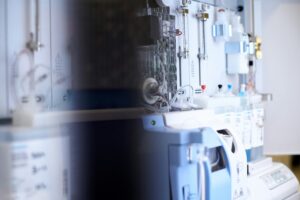Laboratory automation is the use of technology to perform laboratory tasks without direct human intervention. It has revolutionized the field of science and research, making it faster, more accurate, and more efficient. Automation has also helped to reduce the risk of human error, which can be a major source of variability in scientific experiments.
One important area where automation has had a significant impact is chromatography. Chromatography is a separation technique used to identify, quantify, and purify compounds in mixtures. It is widely used in a variety of fields, including chemistry, biochemistry, environmental science, and pharmaceuticals. Traditionally, chromatography was a labor-intensive process that required a great deal of time and effort and it is still problematic today. Samples had to be manually injected into the chromatograph, and the results had to be manually recorded and analyzed. This was not only time-consuming, but it also introduced the potential for human error.
With the advent of laboratory automation, much of this process has been automated. Samples can now be automatically injected into the chromatograph, and the results can be automatically recorded and analyzed using computer software. This has greatly increased the speed and accuracy of chromatographic analyses. In addition to improving the efficiency of the process, automation has also made it possible to perform more complex chromatographic analyses that would have been difficult or impossible using manual methods. For example, automated systems can run multiple samples at the same time, allowing for high-throughput analyses. They can also be programmed to perform multiple separation techniques in a single run, further increasing the complexity and precision of the analysis. Contact LABIO if you want a customized chromatographic solution fitted for your needs.
Reinventing laboratory automation
Overall, the use of automation in chromatography has greatly benefited the scientific community. It has made it faster and easier to identify, quantify, and purify compounds, leading to advances in a wide range of fields. As technology continues to evolve, it is likely that automation will play an even greater role in the future of chromatography and other scientific endeavors. Another important aspect of laboratory automation is the ability to perform experiments without the need for constant human supervision. This is particularly important in situations where experiments must run for long periods of time, or where they need to be performed on a continuous basis.
One example of this is the use of automated liquid handling systems in drug discovery and development. These systems can perform a wide range of tasks, including dispensing and mixing small volumes of liquids, transferring liquids between containers, and pipetting samples. They are often used in high-throughput screening, where large numbers of compounds are tested for their potential as drugs.
They can also perform tasks that are difficult or impossible for humans to do, such as handling hazardous materials or working with very small volumes of liquids. LABIO has developed a cloud-based software, called the ChemExplorer that enables faster chemical measurements and with the right upgrade from the basic package, you will be able to integrate laboratory automation software. Contact LABIO to learn more about our services with software. We have knowledge in creating software for the collection, analysis, processing and reporting that makes your laboratory information management software up to date.
Overall, the use of automation in the laboratory has greatly improved the efficiency and accuracy of scientific research. It has also made it possible to perform experiments that would have been difficult or impossible using manual methods. As technology continues to evolve, it is likely that automation will play an even greater role in the future of scientific research, helping to drive new discoveries and advances in a wide range of fields.




